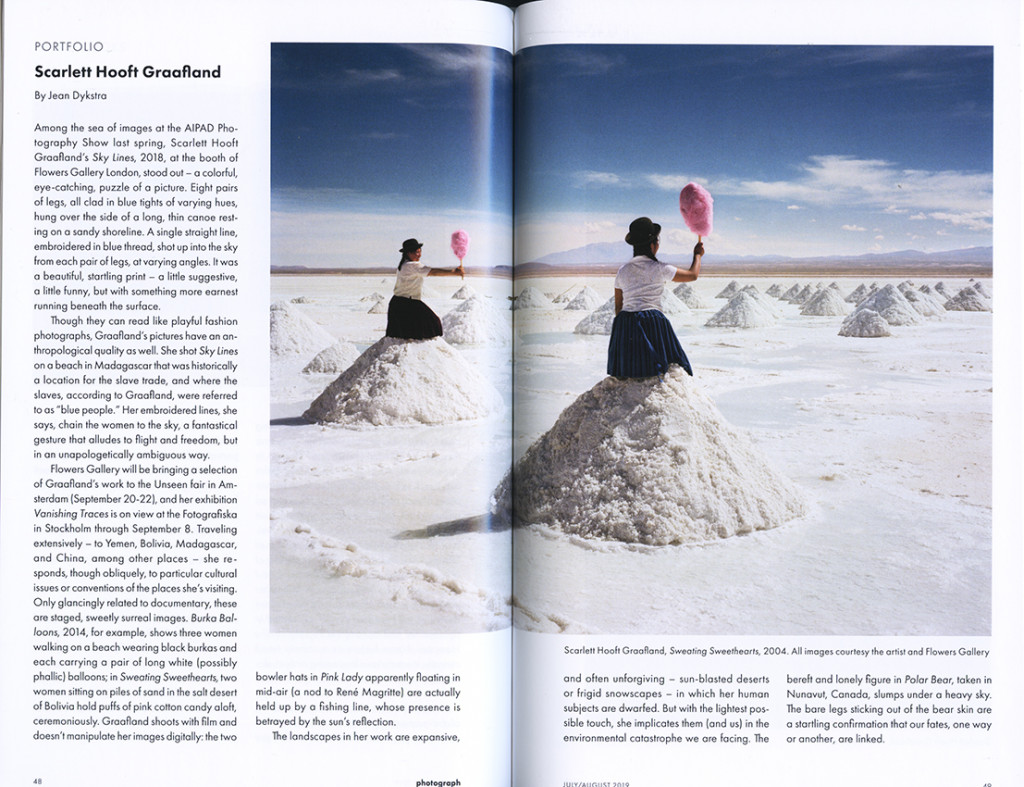
Photograph Magazine
Portfolio
Scarlett Hooft Graafland
By Jean Dykstra
Among the sea of images at the AIPAD Pho¬tography Show last spring, Scarlett Hooft Graafland’s Sky Lines, 2018, at the booth of Flowers Gallery London, stood out – a colorful, eye-catching, puzzle of a picture. Eight pairs of legs, all clad in blue tights of varying hues, hung over the side of a long, thin canoe rest¬ing on a sandy shoreline. A single straight line, embroidered in blue thread, shot up into the sky from each pair of legs, at varying angles. It was a beautiful, startling print – a little suggestive, a little funny, but with something more earnest running beneath the surface.
Though they can read like playful fashion photographs, Graafland’s pictures have an an¬thropological quality as well. She shot Sky Lines on a beach in Madagascar that was historically a location for the slave trade, and where the slaves, according to Graafland, were referred to as “blue people.” Her embroidered lines, she says, chain the women to the sky, a fantastical gesture that alludes to flight and freedom, but in an unapologetically ambiguous way.
Flowers Gallery will be bringing a selection of Graafland’s work to the Unseen fair in Am¬sterdam (September 20-22), and her exhibition Vanishing Traces is on view at the Fotografiska in Stockholm through September 8. Traveling extensively – to Yemen, Bolivia, Madagascar, and China, among other places – she re¬sponds, though obliquely, to particular cultural issues or conventions of the places she’s visiting. Only glancingly related to documentary, these are staged, sweetly surreal images. Burka Bal¬loons, 2014 for example, shows three women walking on the beach wearing black burkas and each carrying a pair of long white (possibly phallic) balloons; in Sweating Sweethearts, two women sitting on piles of sand in the salt desert of Bolivia hold puffs of pink cotton candy aloft, ceremoniously. Graafland shoots with film and doesn’t manipulate het images digitally: the two bowler hats in Pink Lady apparently floating in mid-air (a nod to René Magritte) are actually held up by a fishing line, whose presence is betrayed by the sun’s reflection.
The landscapes in her work are expansive, and often unforgiving – sun-blasted deserts or frigid snowscapes – in which her human subjects are dwarfed. But with the lightest pos¬sible touch, she implicates them (and us) in the environmental catastrophe we are facing. The bereft and lonely figure in Polar Bear, taken in Nunavut, Canada, slumps under a heavy sky. The bare legs sticking out of the bear skin are a startling confirmation that our fates, one way or another, are linked.
Scarlett Hooft Graafland
By Jean Dykstra
Among the sea of images at the AIPAD Pho¬tography Show last spring, Scarlett Hooft Graafland’s Sky Lines, 2018, at the booth of Flowers Gallery London, stood out – a colorful, eye-catching, puzzle of a picture. Eight pairs of legs, all clad in blue tights of varying hues, hung over the side of a long, thin canoe rest¬ing on a sandy shoreline. A single straight line, embroidered in blue thread, shot up into the sky from each pair of legs, at varying angles. It was a beautiful, startling print – a little suggestive, a little funny, but with something more earnest running beneath the surface.
Though they can read like playful fashion photographs, Graafland’s pictures have an an¬thropological quality as well. She shot Sky Lines on a beach in Madagascar that was historically a location for the slave trade, and where the slaves, according to Graafland, were referred to as “blue people.” Her embroidered lines, she says, chain the women to the sky, a fantastical gesture that alludes to flight and freedom, but in an unapologetically ambiguous way.
Flowers Gallery will be bringing a selection of Graafland’s work to the Unseen fair in Am¬sterdam (September 20-22), and her exhibition Vanishing Traces is on view at the Fotografiska in Stockholm through September 8. Traveling extensively – to Yemen, Bolivia, Madagascar, and China, among other places – she re¬sponds, though obliquely, to particular cultural issues or conventions of the places she’s visiting. Only glancingly related to documentary, these are staged, sweetly surreal images. Burka Bal¬loons, 2014 for example, shows three women walking on the beach wearing black burkas and each carrying a pair of long white (possibly phallic) balloons; in Sweating Sweethearts, two women sitting on piles of sand in the salt desert of Bolivia hold puffs of pink cotton candy aloft, ceremoniously. Graafland shoots with film and doesn’t manipulate het images digitally: the two bowler hats in Pink Lady apparently floating in mid-air (a nod to René Magritte) are actually held up by a fishing line, whose presence is betrayed by the sun’s reflection.
The landscapes in her work are expansive, and often unforgiving – sun-blasted deserts or frigid snowscapes – in which her human subjects are dwarfed. But with the lightest pos¬sible touch, she implicates them (and us) in the environmental catastrophe we are facing. The bereft and lonely figure in Polar Bear, taken in Nunavut, Canada, slumps under a heavy sky. The bare legs sticking out of the bear skin are a startling confirmation that our fates, one way or another, are linked.
